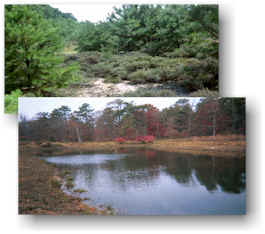Habitats

Brookhaven National Laboratory covers 5,265 acres. Approximately 1,700 acres have been developed near the center of the site. The topography consists of gently rolling terrain with elevations 43.6 to 120.1 feet above sea level within the western rim of the Peconic River watershed.
The site is situated in a deep flow recharge area for Long Island’s sole source aquifer system. Soils are generally porous although some low-lying areas have clay accumulations and have formed wetlands. Six major state and/or federally regulated wetlands exist at BNL, with several additional small pocket wetlands situated along the northern and eastern portions of the property. Vegetation on site is in a variety of successional stages due to such past influences as land clearing, fire, local flooding, draining, and artificial plantings.
Environmental studies conducted at BNL by the U.S. Fish and Wildlife Service, the NYSDEC, the United States Geological Survey (USGS), and recently by Lawler, Matusky and Skelly (LMS 1995), have mapped several wetland areas, have identified 230 plant species, 85 nesting avian species, ten reptilian species, nine amphibian species, 15 mammalian species, nine fish species, and identified 14 confirmed breeding sites for the NYS endangered eastern tiger salamander (Ambystoma tigrinum), and identified a resident population of the NYS "Special Concern" species, the banded sunfish (Enneacanthus obesus) in several sections of the Peconic River on-site. Occasional transient individuals of federal and state listed endangered species utilize the BNL site for resting and feeding during migration including several raptors, including the peregrine falcon (Falco peregrinus), and various species of owls [sawwhet (Aegolius acodicus); short eared (Asio flammeus); great horned (Bubo virginianus); screech (Otys asio); barred (Strix varia)]. In addition, these studies have further identified twelve plant species (including seven fern species) found on-site to be protected under NYS ECL15 ecological communities on or adjacent to BNL and, within the Peconic river corridor on-site, more than 20 inter-related plant communities have been identified and their locations mapped (Inoue and Naidu, 1986).
BNL lands also provide diverse habitat for a host of other wildlife species, which, while not listed as endangered, threatened, or "species of special concern", are important to a viable ecosystem. A site-wide biological inventory has been prepared as part of this effort (LMS 1995). This document details the affected environment and wildlife utilization within a 3.2-mile radius of BNL.


